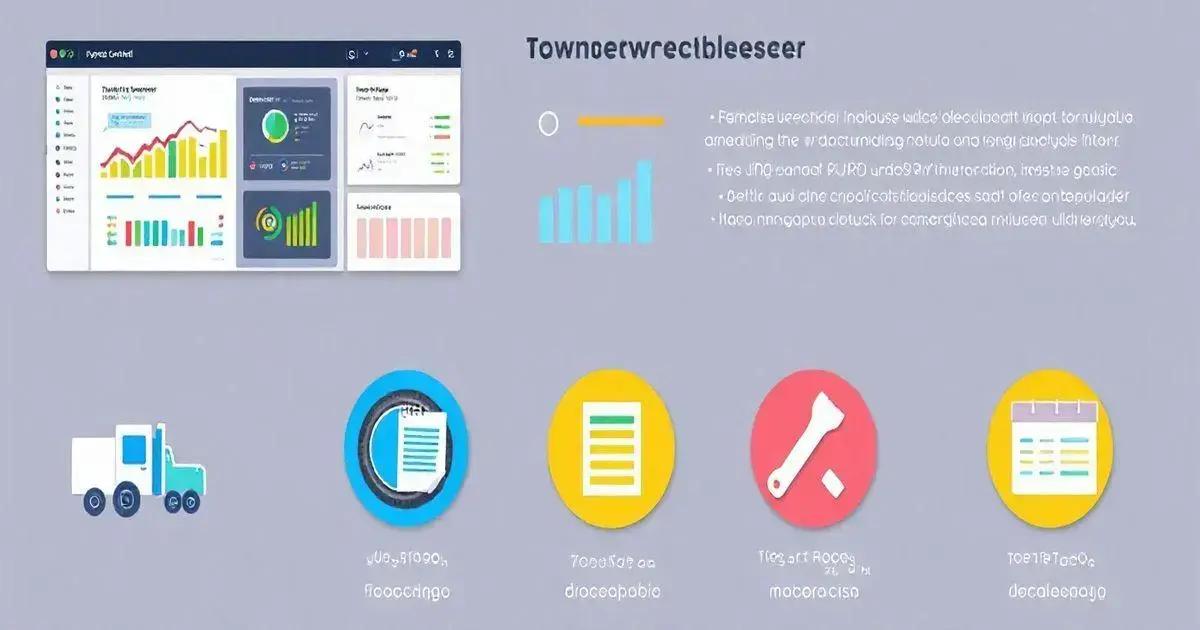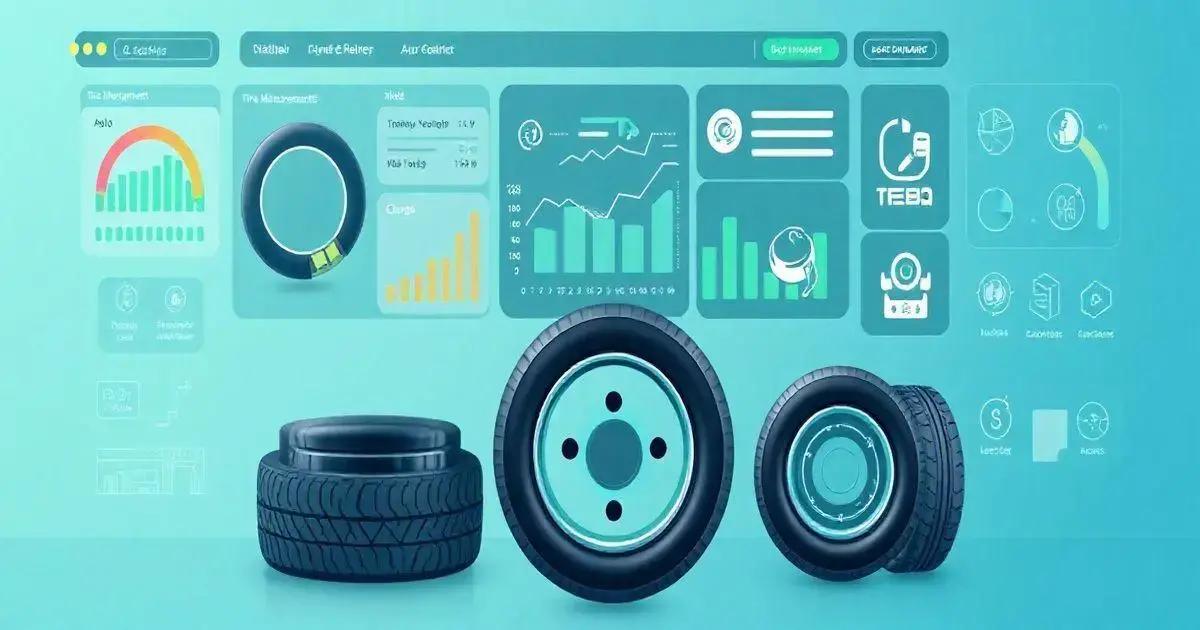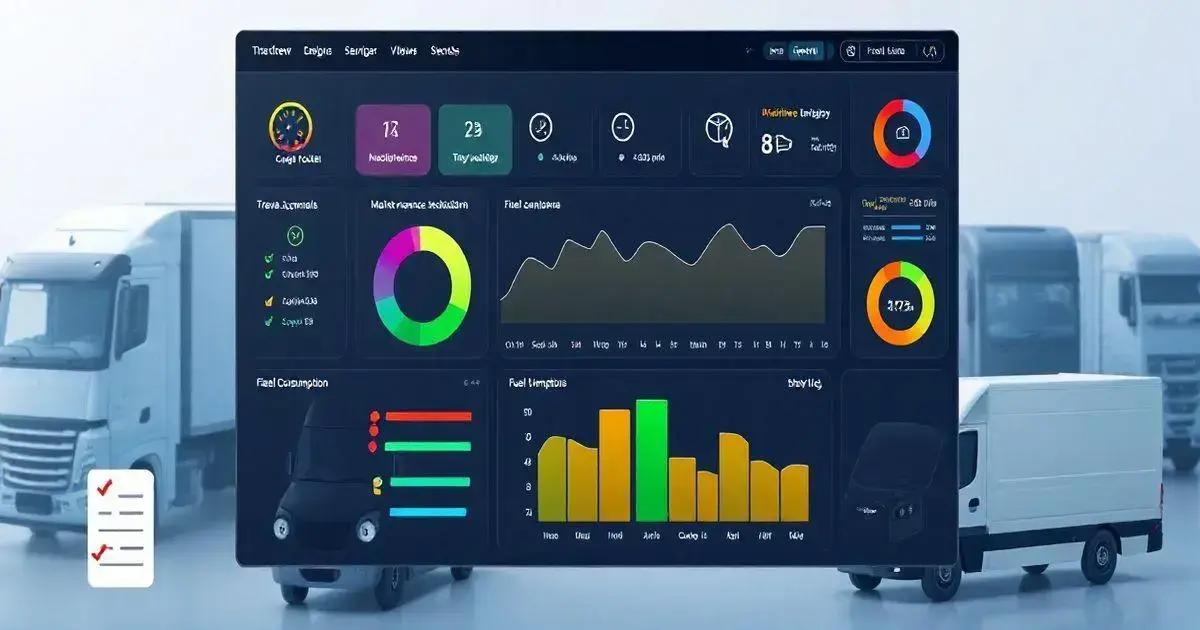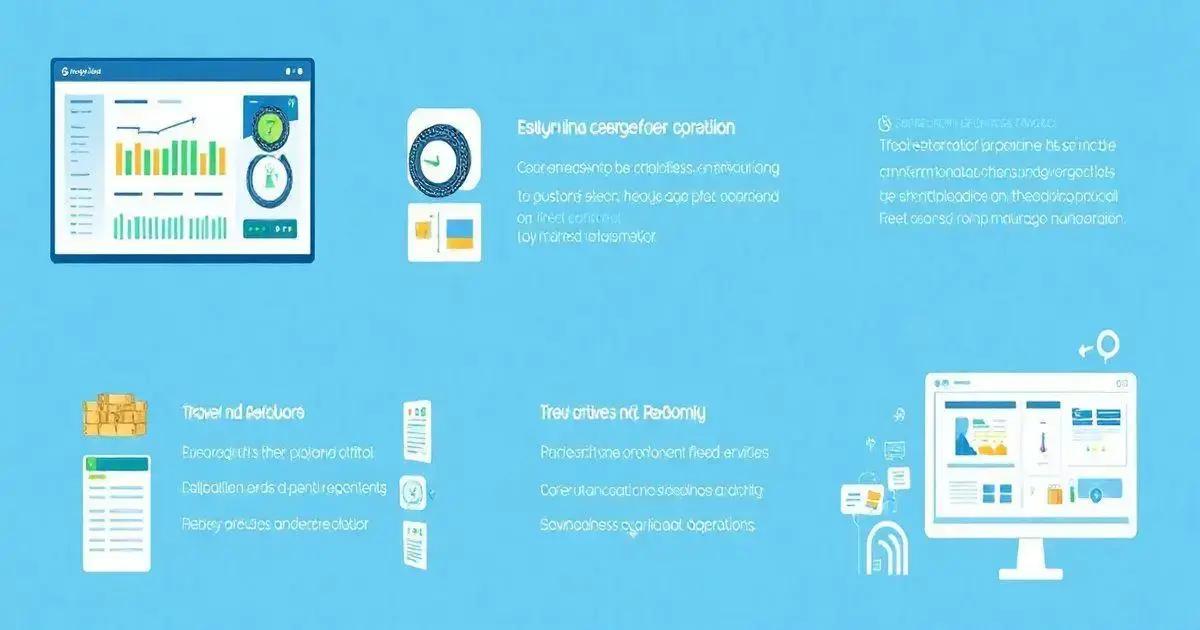Top 5 Benefits of Using Fleet Control Worksheet 7.0 Leave a comment
The Fleet Control Worksheet 7.0 is a vital tool for optimizing fleet management, featuring real-time dashboards, effective travel and cargo management, and preventive maintenance control to reduce downtime and enhance safety. It has proven successful across various industries by lowering operational costs and improving service delivery, making it a strategic partner for businesses seeking efficiency and sustainable growth.
The Fleet Control Worksheet 7.0 is a powerful tool designed to help businesses manage their fleet operations seamlessly. With features such as initial dashboards, travel and cargo control, tire management, and maintenance tracking, it simplifies complex tasks into manageable components. In this article, we will explore the top benefits of using this worksheet to enhance your fleet management.
Key Features of Fleet Control Worksheet 7.0
The Fleet Control Worksheet 7.0 comes packed with a variety of features designed to streamline fleet management, making it essential for any business that relies on transportation. Let’s dive into some of its key features:
Key Features of Fleet Control Worksheet 7.0
- Initial Dashboard: The worksheet provides an intuitive initial dashboard that displays critical metrics at a glance. You can easily track kilometers driven by drivers, average consumption per vehicle, and maintenance costs, giving you a comprehensive view of fleet performance.
- Travel and Cargo Control: This feature allows businesses to manage cargo linked directly to trips. Track the status of each journey, ensuring that all cargo is accounted for and that there are no delays in delivery.
- Tire Control Management: The worksheet includes a dedicated section for tire management, helping you keep tabs on tire changes, schedules, and statuses. This feature prevents excessive wear and tear, ultimately prolonging tire life and improving safety on the road.
- Comprehensive Maintenance Tracking: With both preventive and corrective maintenance tracking, it ensures that your vehicles are in top shape. You can record maintenance types, set schedules for upcoming tasks, and track costs, helping you avoid costly repairs in the future.
- Document Management: The worksheet aids in managing essential documents for both drivers and vehicles, helping you avoid legal complications due to expired documents. This feature reminds you of upcoming renewals, keeping your fleet compliant with regulations.
- User-Friendly Interface: Designed to be user-friendly, the worksheet minimizes the learning curve. Even users with minimal technological expertise can navigate through its features with ease.
These key features not only help in the effective management of fleet operations but also save time and money, making the Fleet Control Worksheet 7.0 a worthwhile investment for any fleet manager.

Importance of Initial Dashboards
The initial dashboards in the Fleet Control Worksheet 7.0 serve as the heartbeat of fleet management, offering an overview of essential metrics that allow fleet managers to make informed decisions quickly. Here’s why these dashboards are so crucial:
1. Real-Time Visibility: Initial dashboards provide real-time visibility into fleet operations. You can see how many kilometers each driver has traveled, the fuel consumption of each vehicle, and the status of maintenance tasks. This immediate access to vital data empowers you to identify issues before they escalate.
2. Performance Tracking: By displaying key performance indicators (KPIs), these dashboards help track the overall efficiency of your fleet. For instance, you can analyze which vehicles are underperforming or which drivers are exceeding fuel consumption benchmarks, enabling targeted interventions.
3. Data-Driven Decision Making: Having a clear visual representation of your fleet’s performance allows for data-driven decision making. This can influence decisions related to vehicle purchases, maintenance scheduling, and route optimization, ultimately leading to cost savings and improved service delivery.
4. User-Friendly Interface: The dashboards are designed for ease of use, allowing even those with limited technical skills to understand complex data. This accessibility ensures that stakeholders at all levels can engage with the data, fostering a more collaborative and informed fleet management culture.
5. Enhanced Accountability: With metrics displayed on the dashboard, accountability is heightened among drivers and maintenance staff. When performance is tracked visually, it encourages individuals to maintain high standards, knowing their contributions are being monitored.
6. Strategic Planning: The insights gained from initial dashboards can also aid in strategic planning. By analyzing trends over time, fleet managers can identify seasonal changes in vehicle usage and plan budgets accordingly, ensuring resources are allocated efficiently.
In summary, the importance of initial dashboards in the Fleet Control Worksheet 7.0 cannot be overstated. They provide a comprehensive lens through which you can view and manage your fleet effectively, driving operational efficiency and ensuring that your business remains competitive in a fast-paced environment.
Managing Travel and Cargo Efficiently
Efficient travel and cargo management is essential for any fleet operation seeking to maximize productivity and minimize costs. The Fleet Control Worksheet 7.0 offers several features that facilitate this process:
Streamlined Trip Planning: The worksheet allows fleet managers to plan trips with detailed itineraries, specifying cargo loads, routes, and estimated travel times. This ensures that all trips are organized efficiently, reducing delays and optimizing resource use.
Cargo Tracking: One of the standout features is the cargo tracking capability. Fleet managers can link cargo details directly to each trip, ensuring that every shipment is accounted for. This minimizes the risk of lost or misplaced cargo, enhancing customer satisfaction.
Integration with Vehicle Management: By integrating travel management with vehicle data, the worksheet provides insights into which vehicles are best suited for specific types of cargo. For instance, heavier payloads can be assigned to trucks with higher capacity, and sensitive cargo can be routed through vehicles equipped with temperature controls.
Cost Management: The worksheet tracks travel expenses in real time, including fuel usage, tolls, and maintenance costs. This allows fleet managers to identify cost-saving opportunities, such as choosing more economical routes or adjusting cargo loads to optimize fuel efficiency.
Reporting and Analytics: After trips are completed, the worksheet generates detailed reports that analyze travel performance. Metrics such as on-time deliveries, fuel efficiency, and cargo condition upon arrival can be evaluated. This analysis helps identify trends and areas for improvement in future operations.
Responsive Alerts: The worksheet can be set up to send alerts for potential issues, such as delays in cargo pickup or drops. This responsiveness allows fleet managers to take corrective actions promptly, ensuring that service commitments are met.
In conclusion, the Fleet Control Worksheet 7.0 equips fleet managers with the tools necessary for managing travel and cargo efficiently, driving operational excellence and fostering better relationships with clients through reliable service delivery.

Effective Tire Management Strategies
Tire management is a critical aspect of fleet operations, directly impacting safety, costs, and vehicle performance.
The Fleet Control Worksheet 7.0 provides several strategies to ensure effective tire management:
Effective Tire Management Strategies
- Regular Tire Inspections: Implement a routine schedule for tire inspections, checking for signs of wear, damage, or improper inflation. The worksheet allows you to log these inspections, making it easier to track tire conditions over time and ensuring that any issues are addressed promptly.
- Tire Change Scheduling: The worksheet includes a feature for scheduling tire changes based on mileage or time intervals. By monitoring tire wear and adhering to a proactive change schedule, you can enhance tire longevity and minimize the risk of blowouts on the road.
- Tracking Tire Performance: Utilize the worksheet to record and analyze tire performance metrics such as mileage per tire, tread depth, and fuel efficiency. This information helps identify underperforming tires that may need replacement or rotation, ensuring optimal vehicle performance.
- Data-Driven Decisions: By compiling data on tire usage and performance, fleet managers can make informed decisions regarding tire purchases and replacements. The worksheet enables you to compare tire brands and types based on performance metrics, helping you select the best options for your fleet’s specific needs.
- Implementing a Tire Maintenance Program: Establish a tire maintenance program that includes rotation schedules, balancing, and alignment checks. The worksheet can help you create and track these maintenance tasks, ensuring all tires are maintained to their full potential and enhancing overall fleet safety.
- Cost Analysis: The worksheet allows for detailed cost analysis of tire management, enabling you to monitor expenditures related to tire purchases, maintenance, and replacements. This insight can help identify cost-saving opportunities, such as negotiating better rates with suppliers or opting for higher-quality tires that may last longer.
By employing these effective tire management strategies with the help of the Fleet Control Worksheet 7.0, fleet managers can improve vehicle safety, extend tire life, and reduce operational costs—all crucial factors for maintaining a successful fleet operation.
Preventive Maintenance Control Explained
Preventive maintenance is a proactive approach aimed at keeping vehicles in optimal condition, minimizing downtime, and avoiding costly repairs. The Fleet Control Worksheet 7.0 offers robust tools for implementing effective preventive maintenance strategies:
Maintenance Scheduling: The worksheet enables you to schedule preventive maintenance tasks based on mileage or time intervals. By setting reminders for regular checks (like oil changes, brake inspections, and fluid levels), fleet managers can ensure that no critical maintenance is overlooked.
Tracking Maintenance History: Each vehicle’s maintenance history can be logged and tracked within the worksheet. This feature allows managers to see what maintenance has been performed, when, and by whom, providing a complete overview of each vehicle’s service record.
Cost Management: Preventive maintenance can help control costs by addressing potential issues before they escalate. The worksheet allows for detailed logging of maintenance expenses, enabling managers to analyze costs over time and adjust strategies accordingly to enhance budget management.
Performance Analysis: By analyzing maintenance records and vehicle performance, fleet managers can identify patterns or recurring issues. This data-driven approach helps optimize vehicle selection and usage, reducing the likelihood of unexpected breakdowns.
Compliance and Safety: Regular preventive maintenance ensures that all vehicles comply with safety standards and regulations. The worksheet can track required inspections and certifications, helping to maintain compliance and ensure driver safety.
Enhanced Resale Value: Keeping a detailed maintenance log through the worksheet can boost the resale value of vehicles. Prospective buyers often look for well-documented maintenance histories as a sign of a vehicle’s reliability and care.
In summary, the preventive maintenance control features of the Fleet Control Worksheet 7.0 empower fleet managers to implement a structured maintenance program that enhances vehicle reliability, improves safety, and saves costs in the long run. By prioritizing preventive maintenance, businesses can ensure their fleet operates efficiently and effectively.

Real-Life Success Stories Using Fleet Control
Implementing the Fleet Control Worksheet 7.0 has led to remarkable transformations in fleet management for various businesses. Here are some real-life success stories showcasing the benefits of this powerful tool:
Real-Life Success Stories Using Fleet Control
- Company A – Improved Efficiency: A logistics company faced challenges with tracking vehicle usage and maintenance schedules. After adopting the Fleet Control Worksheet 7.0, they established an organized tracking system that allowed them to monitor vehicle performance and schedule preventive maintenance efficiently. As a result, they reduced downtime by 30% and significantly improved on-time delivery rates.
- Company B – Cost Reduction: A transportation firm utilized the worksheet to analyze fuel consumption and identify inefficiencies in their routes. By leveraging the data gathered, they optimized their delivery routes and reduced fuel costs by 25%. This strategic move not only saved money but also contributed to lower emissions, helping the company enhance its corporate social responsibility profile.
- Company C – Enhanced Safety: A fleet of delivery vehicles experienced frequent incidents due to maintenance oversights. By implementing the preventive maintenance features of the Fleet Control Worksheet 7.0, they established a rigorous maintenance schedule that ensured all vehicles were regularly inspected and serviced. This proactive approach led to a 40% decrease in accidents and increased driver satisfaction.
- Company D – Streamlined Operations: A large construction company was struggling to manage multiple vehicles across various job sites. The Fleet Control Worksheet 7.0 provided them with a centralized platform to track vehicle assignments and manage documentation. This streamlined their operations, allowing them to allocate resources more effectively, resulting in a 20% increase in productivity across projects.
- Company E – Successful Compliance: A company operating in regulated industries needed to ensure compliance with safety standards. By utilizing the worksheet to maintain detailed logs of maintenance records and inspections, they passed all regulatory audits without issues, avoiding potential fines and enhancing their reputation in the industry.
These success stories illustrate how the Fleet Control Worksheet 7.0 can revolutionize fleet management practices, leading to increased efficiency, cost savings, improved safety, and enhanced compliance. By adopting this tool, businesses can position themselves for long-term success in a competitive landscape.
Conclusion
The Fleet Control Worksheet 7.0 stands out as an invaluable resource for businesses striving to optimize their fleet management.
With its comprehensive features, including initial dashboards, effective travel and cargo management, and robust maintenance tracking, it empowers fleet managers to make informed decisions and enhance operational efficiency.
By implementing effective tire management strategies and leveraging preventive maintenance control, companies can not only extend the life of their vehicles but also ensure compliance and safety.
Real-life success stories highlight the tangible benefits experienced by businesses across various industries, showcasing significant reductions in costs and improvements in service delivery.
In a rapidly changing business environment, adopting such a sophisticated tool is essential for maintaining a competitive edge.
The Fleet Control Worksheet 7.0 is not just a spreadsheet; it’s a strategic partner in your journey toward streamlined operations and sustained growth.
FAQ – Frequently Asked Questions about Fleet Control Worksheet 7.0
What is the Fleet Control Worksheet 7.0?
The Fleet Control Worksheet 7.0 is a comprehensive tool designed for fleet management, providing features for tracking vehicle performance, scheduling maintenance, and managing travel and cargo.
How can the worksheet help reduce operational costs?
By analyzing fuel consumption, optimizing routes, and scheduling preventive maintenance, the worksheet helps identify cost-saving opportunities that can significantly lower operational expenses.
Is the Fleet Control Worksheet user-friendly?
Yes, the worksheet is designed with an intuitive interface, making it accessible for users with varying levels of technical expertise.
Can I track multiple vehicles using this worksheet?
Absolutely! The worksheet allows you to manage and track multiple vehicles simultaneously, making it ideal for any size of fleet.
What types of businesses can benefit from using the Fleet Control Worksheet?
Various businesses, including logistics, transportation, construction, and others that rely on fleet operations, can benefit from using the worksheet.
Is technical support available if I encounter issues with the worksheet?
Yes, users can access technical support during business hours, ensuring assistance is available for any issues or inquiries.

